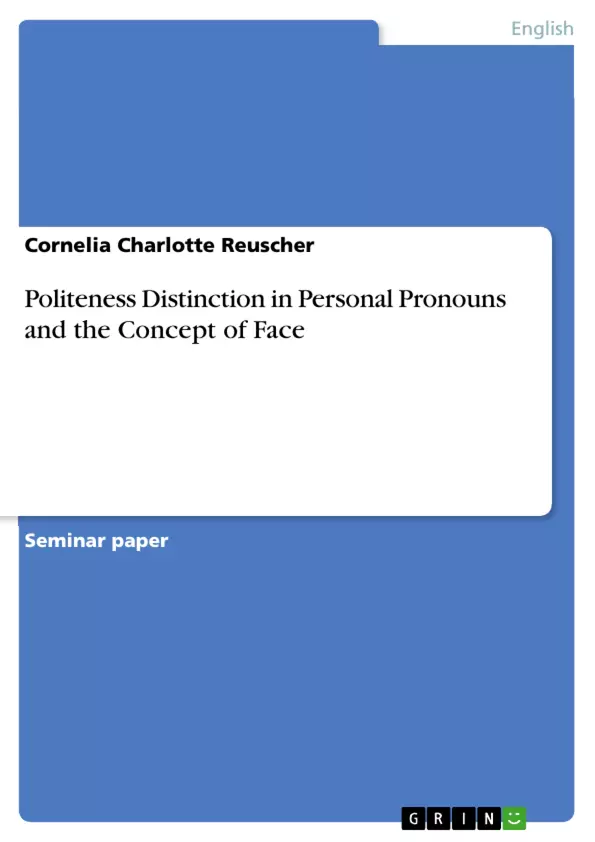1. Introduction
This paper will deal with politeness distinctions in personal pronouns. Thus, le leading question will be: In how far can personal pronouns, being deictic expressions, serve as elements of politeness?
To clarify this a little more, I would like to begin with a short explanation of the term “deictic expression”:
Deictics, also known as “pointing words”, are for example: I, you, here, there, before, after. One can distinguish between person, local and time deixis. Special to deictics is the fact that they are meaningless unless we know who speaks and thus forms the center of orientation - the origo . Personal pronouns, however, form a category of person deixis. They relate to either the addressee or to someone talked about in a conversation, they “characterize the referent as well with respect to the speech act role and the size of the respective speaker and hearer groups.”
In a discourse, personal pronouns lexicalize the relation between the origo, which is the cognitive ground for an act of pointing, and the intended referent, who is the figure of the pointing act. Unlike in local or time deixis, this intended referent is a human being (I will omit the situations when human beings speak to animals here), not an inanimate thing like a piece of furniture or an abstract unit like for example a time span – in short, it makes a difference if I say something like: “Here is the green chair”, or “It rained really hard yesterday.” or if I speak either about “I have met that Mrs. Jones” or directly to “You can leave the room now” other persons. If in direct address or not, the issue of politeness gets important in these cases. We can express distance and dislike in demonstratives as shown in the Mrs. Jones sentence, and we can be nice or rude depending on the form of address we use.
As this paper thus will primarily be focused on person deixis, I will omit the topics of local and time deixis but investigate the use of person deictic expressions in their various uses with regard to the question of politeness.
Therefore, I want to start with a chapter about politeness in general: What is politeness? Why are human beings polite (or impolite)? And how is this politeness conveyed through language? To specify the various strategies used to perform politeness, I will then introduce Brown and Levinson’s concept of “Face”, and, later, draw the link to the use of personal pronouns.
[...)
Inhaltsverzeichnis (Table of Contents)
- Introduction
- Politeness
- The Concept of Face
- Conclusion: Politeness Distinctions in Personal Pronouns in English and German
- Literature
Zielsetzung und Themenschwerpunkte (Objectives and Key Themes)
This paper investigates the role of personal pronouns in expressing politeness. It explores how these deictic expressions, particularly person deixis, contribute to the conveyance of politeness in discourse. The central question is: To what extent can personal pronouns serve as elements of politeness?
- The concept of deixis and its application to personal pronouns.
- The theory of politeness and its connection to the concept of "Face" as defined by Brown and Levinson.
- The analysis of politeness distinctions in personal pronouns in English and German.
- Examples of politeness strategies in language, focusing on the use of personal pronouns.
- The impact of social relationships and hierarchical structures on politeness expressions.
Zusammenfassung der Kapitel (Chapter Summaries)
- Introduction: This chapter introduces the topic of politeness distinctions in personal pronouns, explaining the concept of deixis and its relevance to the study of politeness. It sets the stage for the subsequent analysis of the role of personal pronouns in conveying politeness.
- Politeness: This chapter explores the notion of politeness in language, examining the cooperative principle and its maxims as proposed by Grice. It discusses how politeness can deviate from these maxims and serves not only to convey information but also to maintain social relationships. The concept of "Face" is introduced as a framework for understanding politeness strategies.
- The Concept of "Face": This chapter delves into the concept of "Face" as defined by Erving Goffman and further developed by Brown and Levinson. It explains the distinction between positive and negative face and how these concepts relate to the theory of politeness. Examples are provided to illustrate how speech acts can violate Face, leading to Face-Threatening-Acts (FTAs).
Schlüsselwörter (Keywords)
This paper focuses on the key terms and concepts of politeness, deixis, personal pronouns, face, positive face, negative face, Face-Threatening-Acts (FTAs), and language use in social contexts. The analysis examines the interplay between linguistic features and social dynamics in the expression of politeness, particularly through the use of personal pronouns.
- Citar trabajo
- Cornelia Charlotte Reuscher (Autor), 2006, Politeness Distinction in Personal Pronouns and the Concept of Face, Múnich, GRIN Verlag, https://www.grin.com/document/60171



